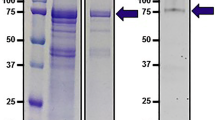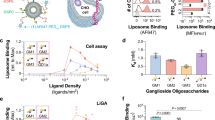Abstract
3′-sialyllactose is one of the abundant components in human milk oligosaccharides (HMOs) that protect infants from various viral infections in early stages of immune system development. 3SL is a combination of lactose and sialic acid. Most sialic acids are widely expressed in animal cells and they bind to siglec proteins. In this study, we demonstrate that 3SL specifically binds to CD33. It induces megakaryocyte differentiation and subsequent apoptosis by targeting cell surface protein siglec-3 (CD33) in human chronic myeloid leukemia K562 cells. The 3SL-bound CD33 was internalized to the cytosol via caveolae-dependent endocytosis. At the molecular level, 3SL-bound CD33 recruits the suppressor of cytokine signaling 3 (SOCS3) and SH2 domain-containing protein tyrosine phosphatase 1 (SHP1). SOCS3 is degraded with CD33 by proteasome degradation, while SHP-1 activates extracellular signal–regulated kinase (ERK) to induce megakaryocytic differentiation and subsequent apoptosis. The present study, therefore, suggests that 3SL is a potential anti-leukemia agent affecting differentiation and apoptosis.








Similar content being viewed by others
References
Bruggencate, S.J., Bovee-Oudenhoven, I.M., Feitsma, A.L., van Hoffen, E., Schoterman, M.H.: Functional role and mechanisms of sialyllactose and other sialylated milk oligosaccharides. Nutr. Rev. 72, 377–389 (2014)
Duncan, P.I., Raymond, F., Fuerholz, A., Sprenger, N.: Sialic acid utilisation and synthesis in the neonatal rat revisited. PLoS One. 4, e8241 (2009)
Sprenger, N., Duncan, P.I.: Sialic acid utilization. Adv. Nutr. 3, 392S–397S (2012)
Vidal, K., van den Broek, P., Lorget, F.: Osteoprotegerin in human milk: a potentialrole in the regulation of bone metabolism and immune development. Pediatr. Res. 55, 1001–1008 (2004)
Jeon, J., Kang, L.J., Lee, K.M., Cho, C., Song, E.K., Kim, W., et al.: 3'-Sialyllactose protects against osteoarthritic development by facilitating cartilage homeostasis. Cell Mol. Med. 22, 57–66 (2018)
Maru, I., Ohta, Y., Okamoto, K., Suzuki, S., Kakehi, K., Tsukada, Y.: Synthesis of Sialyllactose from N-Acetylneuraminic acid and lactose by a neuraminidase from Arthrobacter ureafaciens. Biosci. Biotechnol. Biochem. 56(1557–1561), (1992)
Boehm, G., Stahl, B.: Oligosaccharides from milk. J. Nutr. 137, 847S–849S (2007)
Chung, T.W., Kim, E.Y., Kim, S.J., Choi, H.J., Jang, S.B., Kim, K.J., Ha, S.H., Abekura, F., Kwak, C.H., Kim, C.H., Ha, K.T.: Sialyllactose suppresses angiogenesis by inhibiting VEGFR-2 activation, and tumor progression. Oncotarget. 8, 58152–58162 (2017)
Choi, H., Jin, U.H., Kang, S.K., Abekura, F., Park, J.Y., Kwon, K.M., Suh, S.J., Cho, S.H., Ha, K.T., Lee, Y.C., Chung, T.W., Kim, C.H.: Monosialyl Ganglioside GM3 decreases Apolipoprotein B-100 secretion in liver cells. J. Cell. Biochem. 118, 2168–2181 (2017)
Chung, T.W., Kim, S.J., Choi, H.J., Kim, K.J., Kim, M.J., Kim, S.H., Lee, H.J., Ko, J.H., Lee, Y.C., Suzuki, A., Kim, C.H.: Ganglioside GM3 inhibits VEGF/VEGFR-2-mediated angiogenesis: direct interaction of GM3 with VEGFR-2. Glycobiology. 19, 229–239 (2009)
Kim, S.J., Chung, T.W., Choi, H.J., Jin, U.H., Ha, K.T., Lee, Y.C., Kim, C.H.: Monosialic ganglioside GM3 specifically suppresses the monocyte adhesion to endothelial cells for inflammation. Int. J. Biochem. Cell Biol. 46, 32–38 (2014)
Ha, S.H., Kang, S.K., Choi, H., Kwak, C.H., Abekura, F., Park, J.Y., Kwon, K.M., Chang, H.W., Lee, Y.C., Ha, K.T., Hou, B.K., Chung, T.W., Kim, C.H.: Induction of GD3/α1-adrenergic receptor/transglutaminase 2-mediated erythroid differentiation in chronic myelogenous leukemic K562 cells. Oncotarget. 8, 72205–72219 (2017)
Markowska, A.I., Liu, F.T., Panjwani, N.: Galectin-3 is an important mediator of VEGF- and bFGF-mediated angiogenic response. J. Exp. Med. 207, 1981–1993 (2010)
Chung, T.W., Choi, H.J., Kim, S.J., Kwak, C.H., Song, K.H., Jin, U.H., et al.: The ganglioside GM3 is associated with cisplatin-induced apoptosis in human colon cancer cells. PLoS One. 9, e92786 (2014)
Choi, H.J., Chung, T.W., Kim, S.J., Cho, S.Y., Lee, Y.S., Lee, Y.C., Ko, J.H., Kim, C.H.: The AP-2alpha transcription factor is required for the ganglioside GM3-stimulated transcriptional regulation of a PTEN gene. Glycobiology. 18, 395–407 (2008)
Sohn, H., Kim, Y.S., Kim, H.T., Kim, C.H., Cho, E.W., Kang, H.Y., Kim, N.S., Kim, C.H., Ryu, S.E., Lee, J.H., Ko, J.H.: Ganglioside GM3 is involved in neuronal cell death. FASEB J. 20, 1248–1250 (2006)
Choi, H.J., Chung, T.W., Kang, S.K., Lee, Y.C., Ko, J.H., Kim, J.G., Kim, C.H.: Ganglioside GM3 modulates tumor suppressor PTEN-mediated cell cycle progression--transcriptional induction of p21(WAF1) and p27(kip1) by inhibition of PI-3K/AKT pathway. Glycobiology. 16, 573–583 (2006)
Nguyen, D.H., Ball, E.D., Varki, A.: Myeloid precursors and acute myeloid leukemia cells express multiple CD33-related Siglecs. Exp. Hematol. 34, 728–735 (2006)
Vivier, E., Daeron, M.: Immunoreceptor tyrosine-based inhibition motifs. Immunol. Today. 18, 286–291 (1997)
Ulyanova, T., Blasioli, J., Woodford-Thomas, T.A., Thomas, M.L.: The sialoadhesin CD33 is a myeloid-specific inhibitory receptor. Eur. J. Immunol. 29, 3440–3449 (1999)
Taylor, V.C., Buckley, C.D., Douglas, M., Cody, A.J., Simmons, D.L., Freeman, S.D.: The myeloid-specific sialic acid-binding receptor, CD33, associates with the protein-tyrosine phosphatases, SHP-1 and SHP-2. J. Biol. Chem. 274, 11505–11512 (1999)
Orr, S.J., Morgan, N.M., Elliott, J., Burrows, J.F., Scott, C.J., McVicar, D.W., Johnston, J.A.: CD33 responses are blocked by SOCS3 through accelerated proteasomal-mediated turnover. Blood. 109, 1061–1068 (2007)
Chong, Z.Z., Maiese, K.: The Src homology 2 domain tyrosine phosphatases SHP-1 and SHP-2: diversified control of cell growth, inflammation, and injury. Histol. Histopathol. 22, 1251–1267 (2007)
Balaian, L., Zhong, R.K., Ball, E.D.: The inhibitory effect of anti-CD33 monoclonal antibodies on AML cell growth correlates with Syk and/or ZAP-70 expression. Exp. Hematol. 5, 363–371 (2003)
Bütler, T.M., Ziemiecki, A., Friis, R.R.: Megakaryocytic differentiation of K562 cells is associated with changes in the cytoskeletal organization and the pattern of chromatographically distinct forms of phosphotyrosyl-specific protein phosphatases. Cancer Res. 50, 6323–6329 (1990)
Jacquel, A., Herrant, M., Defamie, V., Belhacene, N., Colosetti, P., Marchetti, S., Legros, L., Deckert, M., Mari, B., Cassuto, J.P., Hofman, P., Auberger, P.: A survey of the signaling pathways involved in megakaryocytic differentiation of the human K562 leukemia cell line by molecular and c-DNA array analysis. Oncogene. 25, 781–794 (2006)
Nakamura, M., Kirito, K., Yamanoi, J., Wainai, T., Nojiri, H., Saito, M.: Ganglioside GM3 can induce megakaryocytoid differentiation of human leukemia cell line K562 cells. Cancer Res. 51, 1940–1945 (1991)
Ouyang, L., Shi, Z., Zhao, S., Wang, F.T., Zhou, T.T., Liu, et al.: Programmed cell death pathways in cancer: a review of apoptosis, autophagy and programmed necrosis. Cell Prolif. 45, 487–498 (2012)
Soldani, C., Scovassi, A.I.: Poly(ADP-ribose) polymerase-1 cleavage during apoptosis: an update. Apoptosis. 7, 321–328 (2002)
Chou, C.C., Yung, B.Y., Hsu, C.Y.: Involvement of nPKC-MAPK pathway in the decrease of nucleophosmin/B23 during megakaryocytic differentiation of human myelogenous leukemia K562 cells. Life Sci. 80, 2051–2059 (2007)
Zhang, H., Tan, S., Wang, J., Chen, S., Quan, J., Xian, J., Zhang, S.S., He, J., Zhang, L.: Musashi2 modulates K562 leukemic cell proliferation and apoptosis involving the MAPK pathway. Exp. Cell Res. 320, 119–127 (2014)
Conde, I., Pabón, D., Jayo, A., Lastres, P., González-Manchón, C.: Involvement of ERK1/2, p38 and PI3K in megakaryocytic differentiation of K562 cells. Eur. J. Haematol. 84, 430–440 (2010)
Mebratu, Y., Tesfaigzi, Y.: How ERK1/2 activation controls cell proliferation and cell death: is subcellular localization the answer? Cell Cycle. 8, 1168–1175 (2009)
Pratsinis, H., Papadopoulou, A., Neidlinger-Wilke, C., Brayda-Bruno, M., Wilke, H.J., Kletsas, D.: Cyclic tensile stress of human annulus fibrosus cells induces MAPK activation: involvement in proinflammatory gene expression. Osteoarthr. Cartil. 24, 679–687 (2016)
Hernández-Caselles, T., Martínez-Esparza, M., Pérez-Oliva, A.B., Quintanilla-Cecconi, A.M., García-Alonso, A., Alvarez-López, D.M., García-Peñarrubia, P.: A study of CD33 (SIGLEC-3) antigen expression and function on activated human T and NK cells: two isoforms of CD33 are generated by alternative splicing. J. Leukoc. Biol. 79, 46–58 (2006)
Walter, R.B., Raden, B.W., Kamikura, D.M., Cooper, J.A., Bernstein, I.D.: Influence of CD33 expression levels and ITIM-dependent internalization on gemtuzumab ozogamicin-induced cytotoxicity. Blood. 105, 1295–1302 (2005)
Griciuc, A., Serrano-Pozo, A., Parrado, A.R., Lesinski, A.N., Asselin, C.N., Mullin, K., Hooli, B., Choi, S.H., Hyman, B.T., Tanzi, R.E.: Alzheimer's disease risk gene CD33 inhibits microglial uptake of amyloid beta. Neuron. 78, 631–643 (2013)
Khan, N.A., Meyneil, J.P., Deschaux, P.: Ca2+/calmodulin and protein kinase C regulation of serotonin transport in human K562 lymphocytes. Cell. Immunol. 172, 269–274 (1996)
Wang, B., Brand-Miller, J., McVeagh, P., Petocz, P., Am, J.: Concentration and distribution of sialic acid in human milk and infant formulas. Clin. Nutr. 74, 510–515 (2001)
Kovtun, Y., Noordhuis, P., Whiteman, K.R., Watkins, K., Jones, G.E., Harvey, L., Lai, K.C., Portwood, S., Adams, S., Sloss, C.M., Schuurhuis, G.J., Ossenkoppele, G., Wang, E.S., Pinkas, J.: IMGN779, a novel CD33-targeting antibody-drug conjugate with DNA alkylating activity, exhibits potent antitumor activity in models of AML. Mol Cancer Ther. 17, 1271–1279 (2018)
Medeiros, B.C., Tanaka, T.N., Balaian, L., Bashey, A., Guzdar, A., Li, H., Messer, K., Ball, E.D.: A phase I/II trial of the combination of Azacitidine and Gemtuzumab Ozogamicin for treatment of relapsed acute myeloid leukemia. Clin. Lymphoma Myeloma Leuk. 18, 346–352 (2018)
Khan, N., Hills, R.K., Virgo, P., Couzens, S., Clark, N., Gilkes, A., Richardson, P., Knapper, S., Grimwade, D., Russell, N.H., Burnett, A.K., Freeman, S.D.: Expression of CD33 is a predictive factor for effect of gemtuzumab ozogamicin at different doses in adult acute myeloid leukaemia. Leukemia. 31, 1059–1068 (2017)
Rubnitz, J.E., Gibson, B., Smith, F.O.: Acute myeloid leukemia. Hematol. Oncol. Clin. North Am. 24, 35–63 (2010)
Burnett, A., Wetzler, M., Löwenberg, B.: Therapeutic advances in acute myeloid leukemia. J. Clin. Oncol. 29, 487–494 (2011)
Damle, N.K., Frost, P.: Antibody-targeted chemotherapy with immunoconjugates of calicheamicin. Curr. Opin. Pharmacol. 3, 386–390 (2003)
Pagano, L., Fianchi, L., Caira, M., Rutella, S., Leone, G.: The role of Gemtuzumab Ozogamicin in the treatment of acute myeloid leukemia patients. Oncogene. 26, 3679–3690 (2007)
Laszlo, G.S., Estey, E.H., Walter, R.B.: The past and future of CD33 as therapeutic target in acute myeloid leukemia. Blood Rev. 28, 143–153 (2014)
Acknowledgements
This study has been in part supported by the Basic Science Research Program through National Research Foundation of Korea (NRF) grant funded by the Ministry of Education, Science and Technology (MEST) of Korea (NRF-2015R1D1A1A01057153).
Author information
Authors and Affiliations
Contributions
S.H.H designed and performed most of experiments and wrote the manuscript. C.H.K (Choong-Hwan Kwak), J.Y.P, F.A performed experiments. Y.C.L, J.S.K, T.W.C and C.H.K (Cheorl-Ho Kim) contributed reagents/ materials/analysis tools, designed and supervised this paper.
Corresponding authors
Ethics declarations
Conflict of interest
The authors did not declare any competing interests in this study. The funders had no role in study design, data collection and analysis, decision to publish, or preparation of the manuscript.
Ethical approval
This article does not contain any studies with human participants or animals performed by any of the authors.
Additional information
Publisher’s note
Springer Nature remains neutral with regard to jurisdictional claims in published maps and institutional affiliations.
Rights and permissions
About this article
Cite this article
Ha, SH., Kwak, CH., Park, JY. et al. 3′-sialyllactose targets cell surface protein, SIGLEC-3, and induces megakaryocyte differentiation and apoptosis by lipid raft-dependent endocytosis. Glycoconj J 37, 187–200 (2020). https://doi.org/10.1007/s10719-019-09902-1
Received:
Revised:
Accepted:
Published:
Issue Date:
DOI: https://doi.org/10.1007/s10719-019-09902-1




